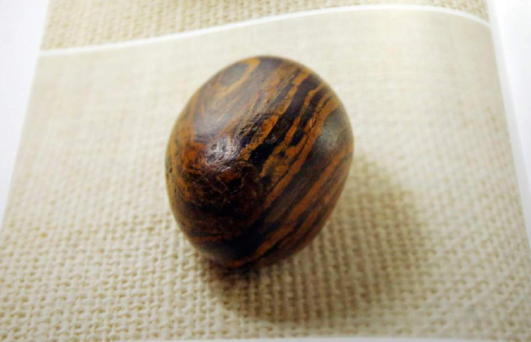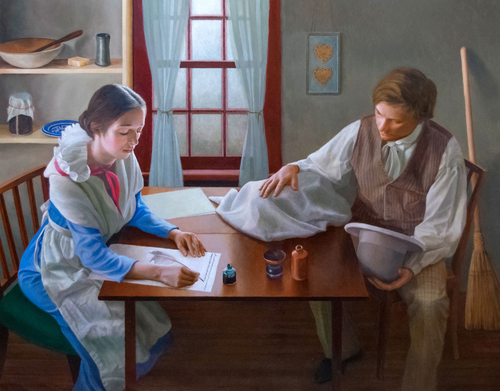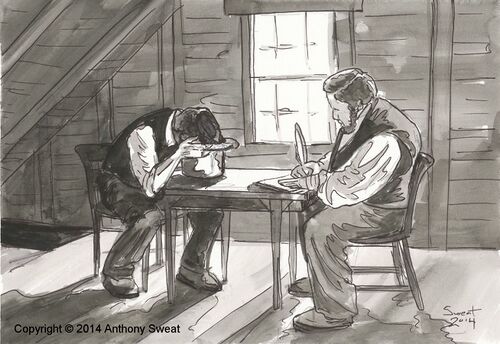
FAIR is a non-profit organization dedicated to providing well-documented answers to criticisms of the doctrine, practice, and history of The Church of Jesus Christ of Latter-day Saints.
No edit summary |
|||
| Line 23: | Line 23: | ||
|answer=In fact, both the seer stone and the Nephite interpreters were used, depending upon the phase of translation. One is no stranger than the other. | |answer=In fact, both the seer stone and the Nephite interpreters were used, depending upon the phase of translation. One is no stranger than the other. | ||
}} | }} | ||
{{:Book of Mormon | {{:Question: Did Joseph Smith use the Nephite interpreters to translate? Or did he use his own seer stone?}} | ||
{{:Question: What are the Nephite interpreters?}} | |||
{{:Question: Did Joseph Smith use his own seer stone to translate the Book of Mormon?}} | |||
{{:Source:Gospel Topics:Joseph Smith and his associates often used the term “Urim and Thummim” to refer to the single stone as well as the interpreters}} | |||
{{:Source:Dirkmaat:Ensign:January 2013:He...referred to it using an Old Testament term, Urim and Thummim...He also sometimes applied the term to other stones he possessed}} | |||
{{:Source:Phelps:The Evening and The Morning Star 1:58:through the aid of a pair of Interpreters, or spectacles—(known, perhaps, in ancient days as Teraphim, or Urim and Thummim)}} | |||
=="this same stone in the hat....from his folk magic days"== | =="this same stone in the hat....from his folk magic days"== | ||
| Treasure digging | A work by author: John Dehlin
|
Historicity of the Book of Mormon |
"(25 June 2014 revision): Joseph Smith used this....stone in the hat....to produce the Book of Mormon"
In fact, both the seer stone and the Nephite interpreters were used, depending upon the phase of translation. One is no stranger than the other.
Joseph Smith used both the Nephite Interpreters and his own seer stone during the translation process, yet we only hear of the "Urim and Thummim" being used for this purpose.
Emma Smith Bidamon described Joseph's use of several stones during translation to Emma Pilgrim on 27 March 1870 (original spelling retained):
Now the first that my <husband> translated, [the book] was translated by use of the Urim, and Thummim, and that was the part that Martin Harris lost, after that he used a small stone, not exactly, black, but was rather a dark color.”[1]

The Lord provided a set of seer stones (which were formerly used by Nephite prophets) along with the plates. The term Nephite interpreters can alternatively refer to the stones themselves or the stones in conjunction with their associated paraphernalia (holding rim and breastplate). Some time after the translation, early saints noticed similarities with the seer stones and related paraphernalia used by High Priests in the Old Testament and began to use the term Urim and Thummim interchangeably with the Nephite interpreters and Joseph's other seer stones as well. The now popular use of the term Urim and Thummim has unfortunately obscured the fact that all such devices belong in the same class of consecrated revelatory aids and that more than one were used in the translation.
The Nephite interpreters were intended to assist Joseph in the initial translation process, yet the manner in which they were employed was never explained in detail. The fact that the Nephite interpreters were set in rims resembling a pair of spectacles has led some to believe that they may have been worn like a pair of glasses, with Joseph viewing the characters on the plates through them. This, however, is merely speculation that doesn't take into account that Joseph soon disassembled the fixture, the spacing between seer stones being too wide for his eyes. The accompanying breastplate also appeared to have been used by a larger man. Like its biblical counterpart (the High Priest's breastplate contained 12 gems that symbolized him acting as a mediator between God and Israel), the Nephite breastplate was apparently non-essential to the revelatory process.



Martin Harris states that Joseph used the Nephite interpreters and then later switched to using the seer stone "for convenience." [2] In fact, Elder Nelson refers to the use of the seer stone in his 1993 talk:
The details of this miraculous method of translation are still not fully known. Yet we do have a few precious insights. David Whitmer wrote:
“Joseph Smith would put the seer stone into a hat, and put his face in the hat, drawing it closely around his face to exclude the light; and in the darkness the spiritual light would shine. A piece of something resembling parchment would appear, and on that appeared the writing. One character at a time would appear, and under it was the interpretation in English. Brother Joseph would read off the English to Oliver Cowdery, who was his principal scribe, and when it was written down and repeated to Brother Joseph to see if it was correct, then it would disappear, and another character with the interpretation would appear. Thus the Book of Mormon was translated by the gift and power of God, and not by any power of man.” (David Whitmer, An Address to All Believers in Christ, Richmond, Mo.: n.p., 1887, p. 12.) [3]
Gospel Topics on LDS.org:
These two instruments—the interpreters and the seer stone—were apparently interchangeable and worked in much the same way such that, in the course of time, Joseph Smith and his associates often used the term “Urim and Thummim” to refer to the single stone as well as the interpreters. In ancient times, Israelite priests used the Urim and Thummim to assist in receiving divine communications. Although commentators differ on the nature of the instrument, several ancient sources state that the instrument involved stones that lit up or were divinely illumin[at]ed. Latter-day Saints later understood the term “Urim and Thummim” to refer exclusively to the interpreters. Joseph Smith and others, however, seem to have understood the term more as a descriptive category of instruments for obtaining divine revelations and less as the name of a specific instrument. [4]
Gerrit Dirkmaat (Church History Department - January 2013 Ensign):
Those who believed that Joseph Smith’s revelations contained the voice of the Lord speaking to them also accepted the miraculous ways in which the revelations were received. Some of the Prophet Joseph’s earliest revelations came through the same means by which he translated the Book of Mormon from the gold plates. In the stone box containing the gold plates, Joseph found what Book of Mormon prophets referred to as “interpreters,” or a “stone, which shall shine forth in darkness unto light” (Alma 37:23–24). He described the instrument as “spectacles” and referred to it using an Old Testament term, Urim and Thummim (see Exodus 28:30).2
He also sometimes applied the term to other stones he possessed, called “seer stones” because they aided him in receiving revelations as a seer. The Prophet received some early revelations through the use of these seer stones. For example, shortly after Oliver Cowdery came to serve as a scribe for Joseph Smith as he translated the plates, Oliver and Joseph debated the meaning of a biblical passage and sought an answer through revelation. Joseph explained: “A difference of opinion arising between us about the account of John the Apostle … whether he died, or whether he continued; we mutually agreed to settle it by the Urim and Thummim.”3 In response, Joseph Smith received the revelation now known as section 7 of the Doctrine and Covenants, which informed them that Jesus had told the Apostle John, “Thou shalt tarry until I come in my glory” (D&C 7:3).
Records indicate that soon after the founding of the Church in 1830, the Prophet stopped using the seer stones as a regular means of receiving revelations. Instead, he dictated the revelations after inquiring of the Lord without employing an external instrument. One of his scribes explained that process: “The scribe seats himself at a desk or table, with pen, ink, and paper. The subject of inquiry being understood, the Prophet and Revelator inquires of God. He spiritually sees, hears, and feels, and then speaks as he is moved upon by the Holy Ghost.”[5]
W.W. Phelps wrote the following in the January 1833 edition of The Evening and The Morning Star:
The book of Mormon, as a revelation from God, possesses some advantage over the old scripture: it has not been tinctured by the wisdom of man, with here and there an Italic word to supply deficiencies.-It was translated by the gift and power of God, by an unlearned man, through the aid of a pair of Interpreters, or spectacles-(known, perhaps, in ancient days as Teraphim, or Urim and Thummim) and while it unfolds the history of the first inhabitants that settled this continent, it, at the same time, brings a oneness to scripture, like the days of the apostles; and opens and explains the prophecies, that a child may understand the meaning of many of them; and shows how the Lord will gather his saints, even the children of Israel, that have been scattered over the face of the earth, more than two thousand years, in these last days, to the place of the name of the Lord of hosts, the mount Zion. [6]
It appears that the seer stone was also referred to as the "Urim and Thummim" after 1833, indicating that the name could be assigned to any device that was used for the purpose of translation.[7]
"(25 June 2014 revision): this same stone in the hat....from his folk magic days"
How was Joseph to learn to be a prophet from scratch? God allowed Joseph to develop confidence via a method in which he and others already believed he had skill.
Jump to details:
"(25 June 2014 revision): this 'translation' process did not involve the golden plates"
According to Joseph Fielding Smith, Joseph Smith did not immediately translate the Book of Mormon but was initially involved in a period of study and investigation. President Smith wrote that although "nothing was done towards translating the record that year [1827]," Joseph "was busy studying the characters and making himself familiar with them and the use of the Urim and Thummim. He had a great deal more to do than merely to sit down and with the use of the instrument prepared for that purpose translate the characters on the plates." President Smith concluded: "Nothing worth while comes to us merely for the asking. All knowledge and skill are obtained by consistent and determined study and practice, and so the Prophet found it to be the case in the translating of the Book of Mormon."[8]
Links to related information:
"(25 June 2014 revision): which begs the question as to why the plates were needed at all?"
The question has a simple answer, even if the author refuses to acknowledge it. If there were no plates, it would be easy—as many cultural Mormons and critics have tried to do anyway—to claim that the Book of Mormon was an "inspired fiction." The existence of real, literal plates seen and handled by witnesses is evidence that the Nephites really existed. The Book of Mormon story is not a mere allegory or fiction—it is real history, about real people, who meet a real, genuine, living Christ.
The plates also probably helped reassure Joseph and those close to him that he was not crazy, or delusional, or lying—he had genuine, tangible artifacts.
Jump to details:
Notes

FAIR is a non-profit organization dedicated to providing well-documented answers to criticisms of the doctrine, practice, and history of The Church of Jesus Christ of Latter-day Saints.
We are a volunteer organization. We invite you to give back.
Donate Now